open hood Lancia Thema 2013 Owner handbook (in English)
[x] Cancel search | Manufacturer: LANCIA, Model Year: 2013, Model line: Thema, Model: Lancia Thema 2013Pages: 336, PDF Size: 3.87 MB
Page 21 of 336
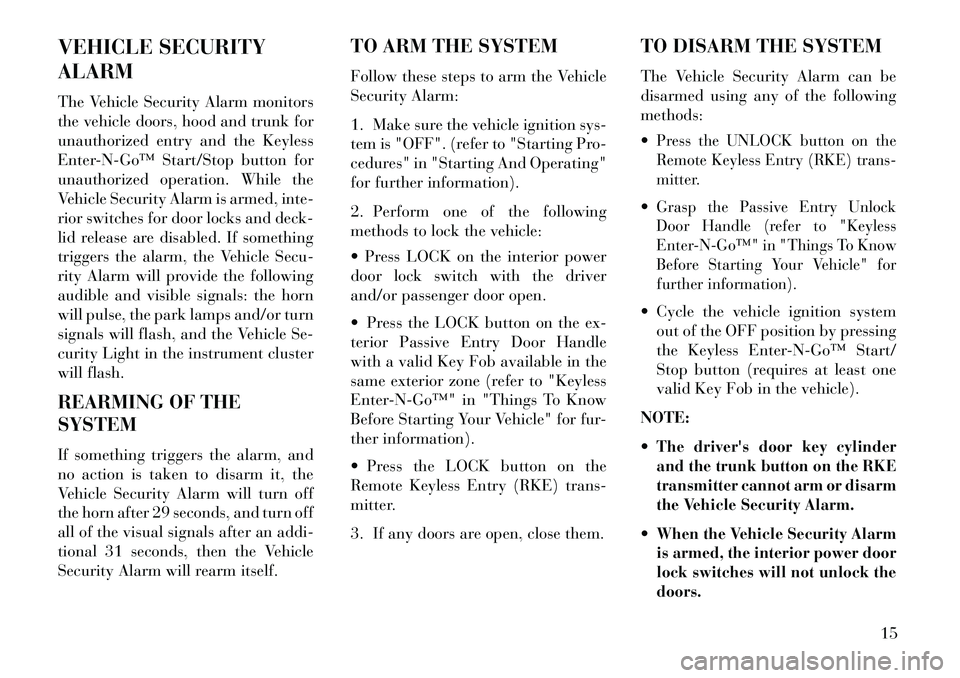
VEHICLE SECURITY
ALARM
The Vehicle Security Alarm monitors
the vehicle doors, hood and trunk for
unauthorized entry and the Keyless
EnterNGo™ Start/Stop button for
unauthorized operation. While the
Vehicle Security Alarm is armed, inte-
rior switches for door locks and deck-
lid release are disabled. If something
triggers the alarm, the Vehicle Secu-
rity Alarm will provide the following
audible and visible signals: the horn
will pulse, the park lamps and/or turn
signals will flash, and the Vehicle Se-
curity Light in the instrument cluster
will flash.
REARMING OF THE
SYSTEM
If something triggers the alarm, and
no action is taken to disarm it, the
Vehicle Security Alarm will turn off
the horn after 29 seconds, and turn off
all of the visual signals after an addi-
tional 31 seconds, then the Vehicle
Security Alarm will rearm itself.TO ARM THE SYSTEM
Follow these steps to arm the Vehicle
Security Alarm:
1. Make sure the vehicle ignition sys-
tem is "OFF". (refer to "Starting Pro-
cedures" in "Starting And Operating"
for further information).
2. Perform one of the following
methods to lock the vehicle:
Press LOCK on the interior power
door lock switch with the driver
and/or passenger door open.
Press the LOCK button on the ex-
terior Passive Entry Door Handle
with a valid Key Fob available in the
same exterior zone (refer to "Keyless
EnterNGo™" in "Things To Know
Before Starting Your Vehicle" for fur-
ther information).
Press the LOCK button on the
Remote Keyless Entry (RKE) trans-
mitter.
3. If any doors are open, close them.
TO DISARM THE SYSTEM
The Vehicle Security Alarm can be
disarmed using any of the following
methods:
Press the UNLOCK button on the
Remote Keyless Entry (RKE) trans-
mitter.Grasp the Passive Entry Unlock
Door Handle (refer to "Keyless
EnterNGo™" in "Things To Know
Before Starting Your Vehicle" for
further information). Cycle the vehicle ignition system
out of the OFF position by pressing
the Keyless EnterNGo™ Start/
Stop button (requires at least one
valid Key Fob in the vehicle).
NOTE:
The driver's door key cylinder
and the trunk button on the RKE
transmitter cannot arm or disarm
the Vehicle Security Alarm.When the Vehicle Security Alarm
is armed, the interior power door
lock switches will not unlock the
doors.
15
Page 22 of 336
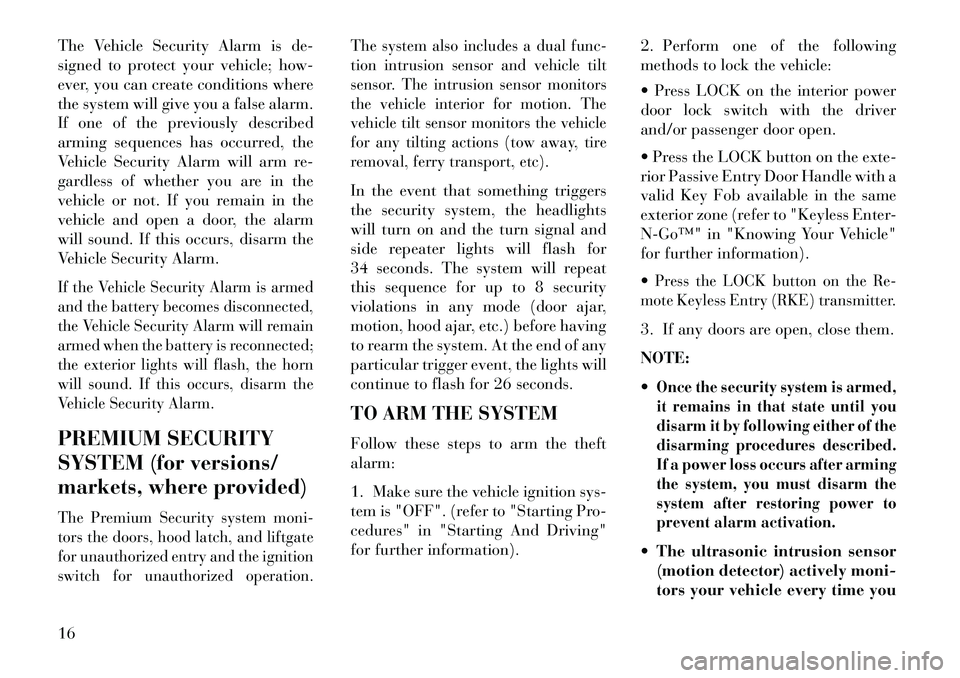
The Vehicle Security Alarm is de-
signed to protect your vehicle; how-
ever, you can create conditions where
the system will give you a false alarm.
If one of the previously described
arming sequences has occurred, the
Vehicle Security Alarm will arm re-
gardless of whether you are in the
vehicle or not. If you remain in the
vehicle and open a door, the alarm
will sound. If this occurs, disarm the
Vehicle Security Alarm.If the Vehicle Security Alarm is armed
and the battery becomes disconnected,
the Vehicle Security Alarm will remain
armed when the battery is reconnected;
the exterior lights will flash, the horn
will sound. If this occurs, disarm the
Vehicle Security Alarm.PREMIUM SECURITY
SYSTEM (for versions/
markets, where provided)The Premium Security system moni-
tors the doors, hood latch, and liftgate
for unauthorized entry and the ignition
switch for unauthorized operation.The system also includes a dual func-
tion intrusion sensor and vehicle tilt
sensor. The intrusion sensor monitors
the vehicle interior for motion. The
vehicle tilt sensor monitors the vehicle
for any tilting actions (tow away, tire
removal, ferry transport, etc).
In the event that something triggers
the security system, the headlights
will turn on and the turn signal and
side repeater lights will flash for
34 seconds. The system will repeat
this sequence for up to 8 security
violations in any mode (door ajar,
motion, hood ajar, etc.) before having
to rearm the system. At the end of any
particular trigger event, the lights will
continue to flash for 26 seconds.
TO ARM THE SYSTEM
Follow these steps to arm the theft
alarm:
1. Make sure the vehicle ignition sys-
tem is "OFF". (refer to "Starting Pro-
cedures" in "Starting And Driving"
for further information).
2. Perform one of the following
methods to lock the vehicle:
Press LOCK on the interior power
door lock switch with the driver
and/or passenger door open.
Press the LOCK button on the exte-
rior Passive Entry Door Handle with a
valid Key Fob available in the same
exterior zone (refer to "Keyless Enter-
NGo™" in "Knowing Your Vehicle"
for further information).
Press the LOCK button on the Re-
mote Keyless Entry (RKE) transmitter.3. If any doors are open, close them.
NOTE:
Once the security system is armed,
it remains in that state until you
disarm it by following either of the
disarming procedures described.
If a power loss occurs after arming
the system, you must disarm the
system after restoring power to
prevent alarm activation. The ultrasonic intrusion sensor (motion detector) actively moni-
tors your vehicle every time you
16
Page 33 of 336
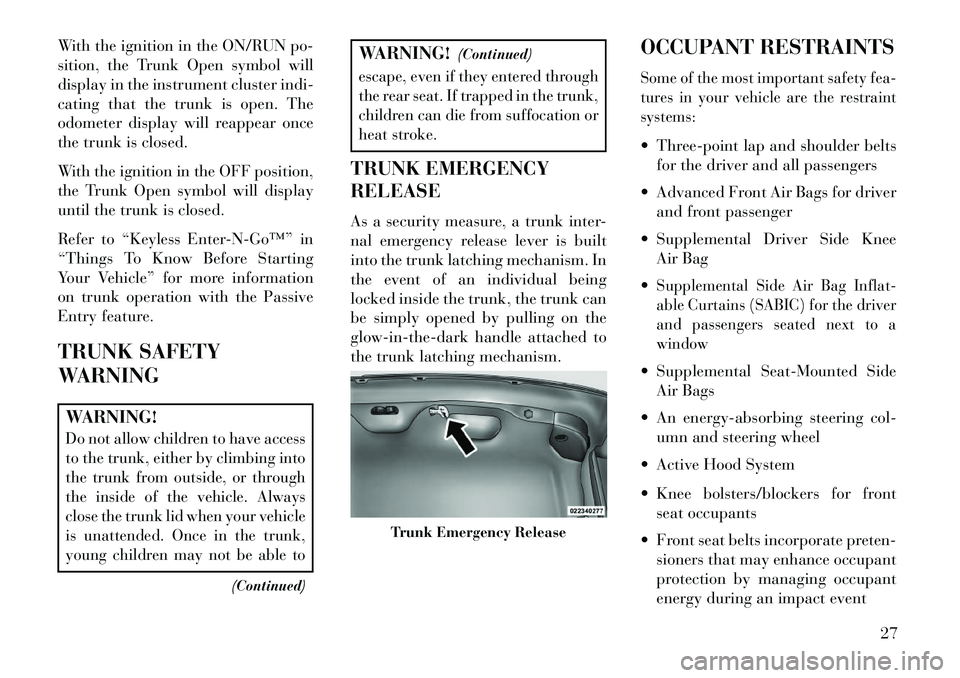
With the ignition in the ON/RUN po-
sition, the Trunk Open symbol will
display in the instrument cluster indi-
cating that the trunk is open. The
odometer display will reappear once
the trunk is closed.
With the ignition in the OFF position,
the Trunk Open symbol will display
until the trunk is closed.
Refer to “Keyless EnterNGo™” in
“Things To Know Before Starting
Your Vehicle” for more information
on trunk operation with the Passive
Entry feature.
TRUNK SAFETY
WARNINGWARNING!Do not allow children to have access
to the trunk, either by climbing into
the trunk from outside, or through
the inside of the vehicle. Always
close the trunk lid when your vehicle
is unattended. Once in the trunk,
young children may not be able to
(Continued)
WARNING!(Continued)escape, even if they entered through
the rear seat. If trapped in the trunk,
children can die from suffocation or
heat stroke.TRUNK EMERGENCY
RELEASE
As a security measure, a trunk inter-
nal emergency release lever is built
into the trunk latching mechanism. In
the event of an individual being
locked inside the trunk, the trunk can
be simply opened by pulling on the
glow-in-the-dark handle attached to
the trunk latching mechanism. OCCUPANT RESTRAINTS
Some of the most important safety fea-
tures in your vehicle are the restraint
systems: Three-point lap and shoulder belts
for the driver and all passengers
Advanced Front Air Bags for driver and front passenger
Supplemental Driver Side Knee Air Bag
Supplemental Side Air Bag Inflat-
able Curtains (SABIC) for the driver
and passengers seated next to a
window Supplemental Seat-Mounted Side Air Bags
An energy-absorbing steering col- umn and steering wheel
Active Hood System
Knee bolsters/blockers for front seat occupants
Front seat belts incorporate preten- sioners that may enhance occupant
protection by managing occupant
energy during an impact event
Trunk Emergency Release
27
Page 67 of 336
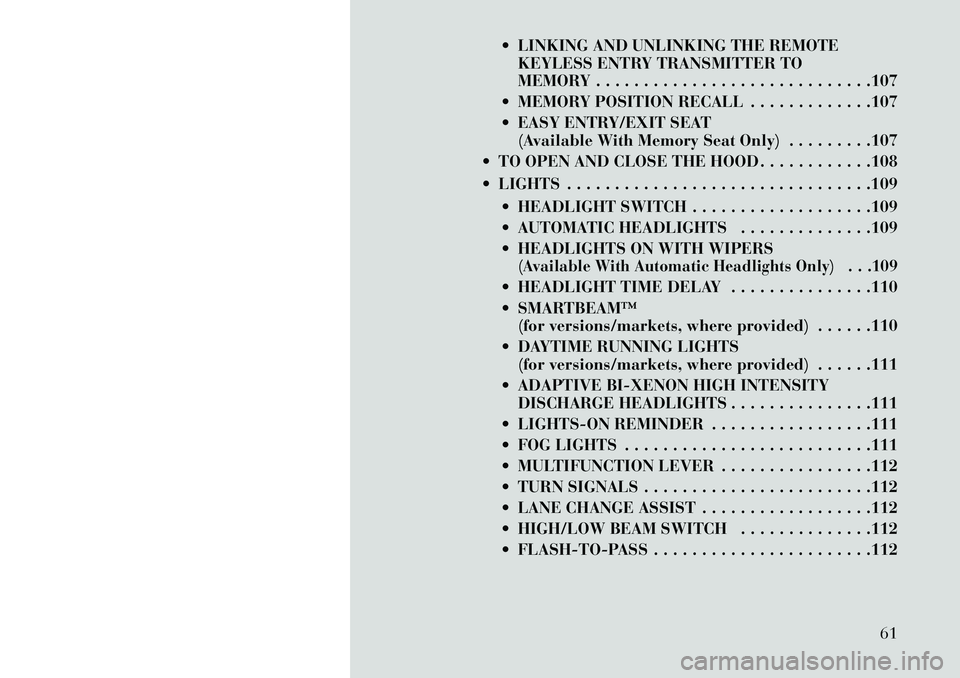
LINKING AND UNLINKING THE REMOTEKEYLESS ENTRY TRANSMITTER TO
MEMORY . . . . . . . . . . . . . . . . . . . . . . . . . . . . .107
MEMORY POSITION RECALL . . . . . . . . . . . . .107
EASY ENTRY/EXIT SEAT (Available With Memory Seat Only) . . . . . . . . .107
TO OPEN AND CLOSE THE HOOD . . . . . . . . . . . .108
LIGHTS . . . . . . . . . . . . . . . . . . . . . . . . . . . . . . . .109
HEADLIGHT SWITCH . . . . . . . . . . . . . . . . . . .109
AUTOMATIC HEADLIGHTS . . . . . . . . . . . . . .109
HEADLIGHTS ON WITH WIPERS(Available With Automatic Headlights Only) . . .109 HEADLIGHT TIME DELAY . . . . . . . . . . . . . . .110
SMARTBEAM™(for versions/markets, where provided) . . . . . .110
DAYTIME RUNNING LIGHTS (for versions/markets, where provided) . . . . . .111
ADAPTIVE BI-XENON HIGH INTENSITY DISCHARGE HEADLIGHTS . . . . . . . . . . . . . . .111
LIGHTS-ON REMINDER . . . . . . . . . . . . . . . . .111
FOG LIGHTS . . . . . . . . . . . . . . . . . . . . . . . . . .111
MULTIFUNCTION LEVER . . . . . . . . . . . . . . . .112
TURN SIGNALS . . . . . . . . . . . . . . . . . . . . . . . .112
LANE CHANGE ASSIST . . . . . . . . . . . . . . . . . .112
HIGH/LOW BEAM SWITCH . . . . . . . . . . . . . .112
FLASH-TO-PASS . . . . . . . . . . . . . . . . . . . . . . .112
61
Page 114 of 336
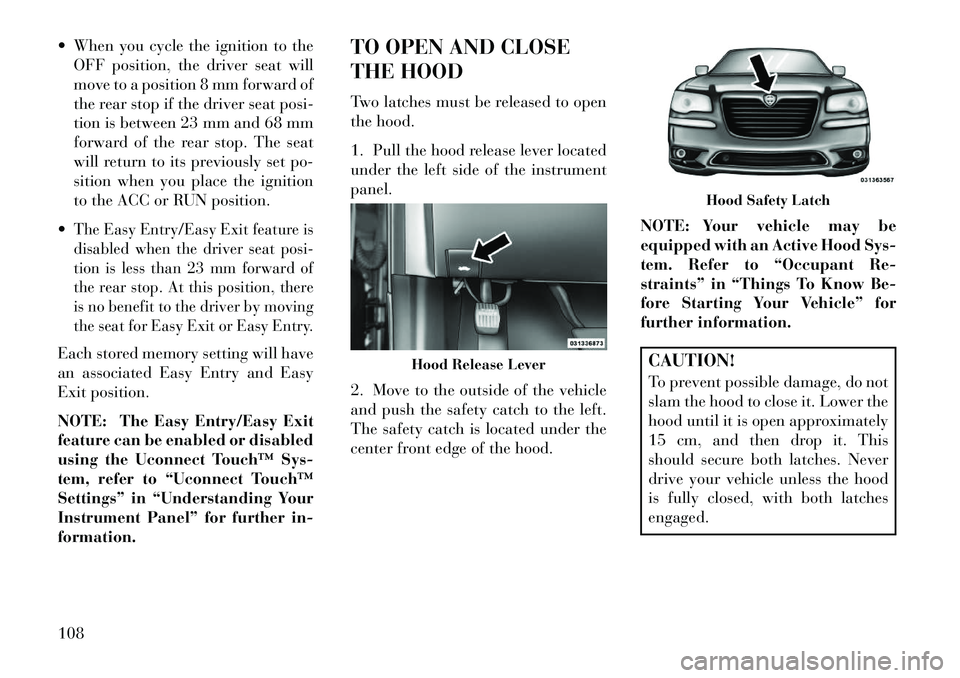
When you cycle the ignition to theOFF position, the driver seat will
move to a position 8 mm forward of
the rear stop if the driver seat posi-
tion is between 23 mm and 68 mm
forward of the rear stop. The seat
will return to its previously set po-
sition when you place the ignition
to the ACC or RUN position.
The Easy Entry/Easy Exit feature is
disabled when the driver seat posi-
tion is less than 23 mm forward of
the rear stop. At this position, there
is no benefit to the driver by moving
the seat for Easy Exit or Easy Entry.Each stored memory setting will have
an associated Easy Entry and Easy
Exit position.
NOTE: The Easy Entry/Easy Exit
feature can be enabled or disabled
using the Uconnect Touch™ Sys-
tem, refer to “Uconnect Touch™
Settings” in “Understanding Your
Instrument Panel” for further in-
formation. TO OPEN AND CLOSE
THE HOOD
Two latches must be released to open
the hood.
1. Pull the hood release lever located
under the left side of the instrument
panel.
2. Move to the outside of the vehicle
and push the safety catch to the left.
The safety catch is located under the
center front edge of the hood.
NOTE: Your vehicle may be
equipped with an Active Hood Sys-
tem. Refer to “Occupant Re-
straints” in “Things To Know Be-
fore Starting Your Vehicle” for
further information.
CAUTION!
To prevent possible damage, do not
slam the hood to close it. Lower the
hood until it is open approximately
15 cm, and then drop it. This
should secure both latches. Never
drive your vehicle unless the hood
is fully closed, with both latches
engaged.
Hood Release Lever
Hood Safety Latch
108
Page 115 of 336
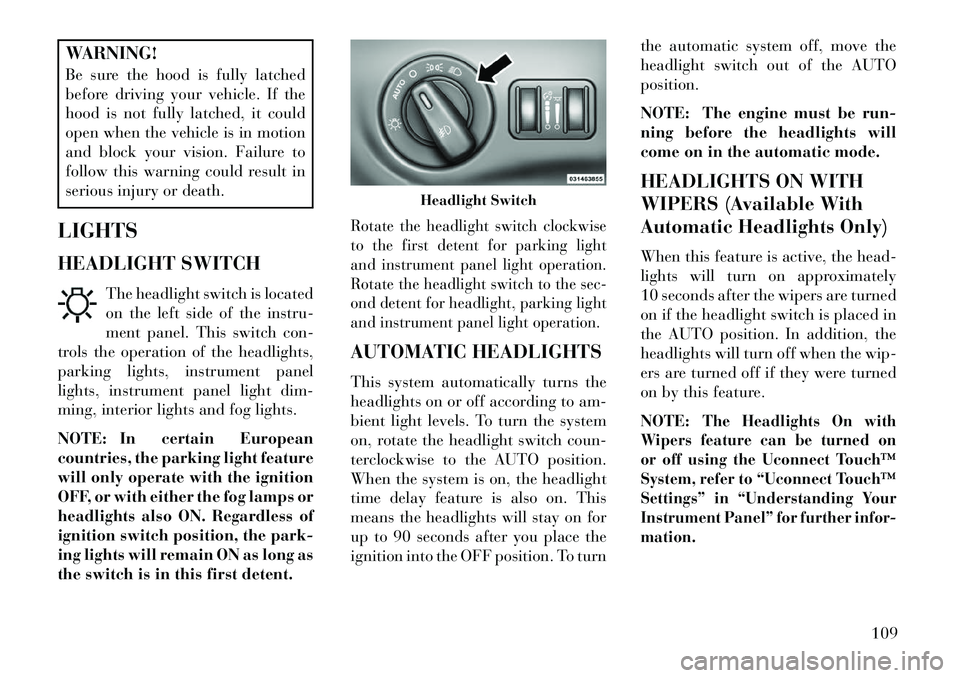
WARNING!
Be sure the hood is fully latched
before driving your vehicle. If the
hood is not fully latched, it could
open when the vehicle is in motion
and block your vision. Failure to
follow this warning could result in
serious injury or death.
LIGHTS
HEADLIGHT SWITCH The headlight switch is located
on the left side of the instru-
ment panel. This switch con-
trols the operation of the headlights,
parking lights, instrument panel
lights, instrument panel light dim-
ming, interior lights and fog lights.
NOTE: In certain European
countries, the parking light feature
will only operate with the ignition
OFF, or with either the fog lamps or
headlights also ON. Regardless of
ignition switch position, the park-
ing lights will remain ON as long as
the switch is in this first detent.
Rotate the headlight switch clockwise
to the first detent for parking light
and instrument panel light operation.
Rotate the headlight switch to the sec-
ond detent for headlight, parking light
and instrument panel light operation.AUTOMATIC HEADLIGHTS
This system automatically turns the
headlights on or off according to am-
bient light levels. To turn the system
on, rotate the headlight switch coun-
terclockwise to the AUTO position.
When the system is on, the headlight
time delay feature is also on. This
means the headlights will stay on for
up to 90 seconds after you place the
ignition into the OFF position. To turn the automatic system off, move the
headlight switch out of the AUTO
position.
NOTE: The engine must be run-
ning before the headlights will
come on in the automatic mode.
HEADLIGHTS ON WITH
WIPERS (Available With
Automatic Headlights Only)
When this feature is active, the head-
lights will turn on approximately
10 seconds after the wipers are turned
on if the headlight switch is placed in
the AUTO position. In addition, the
headlights will turn off when the wip-
ers are turned off if they were turned
on by this feature.
NOTE:
The Headlights On with
Wipers feature can be turned on
or off using the Uconnect Touch™
System, refer to “Uconnect Touch™
Settings” in “Understanding Your
Instrument Panel” for further infor-
mation.
Headlight Switch
109
Page 260 of 336

HAZARD WARNING
FLASHERS
The Hazard Warning flasher switch is
located in the center of the instrument
panel between the center air outlets.Press the switch to turn on the
Hazard Warning flashers.
When the switch is activated, all di-
rectional turn signals will flash on and
off to warn oncoming traffic of an
emergency. Press the switch a second
time to turn off the Hazard Warning
flashers.
This is an emergency warning system
and it should not be used when the
vehicle is in motion. Use it when your
vehicle is disabled and it is creating a
safety hazard for other motorists.
When you must leave the vehicle to
seek assistance, the Hazard Warning
flashers will continue to operate even
though the ignition is placed in the
OFF position.
NOTE: With extended use the
Hazard Warning flashers may
wear down your battery. IF YOUR ENGINE
OVERHEATS
In any of the following situations, you
can reduce the potential for overheat-
ing by taking the appropriate action.
On the highways — slow down.
In city traffic — while stopped,
place the transmission in NEU-
TRAL, but do not increase the en-
gine idle speed.
NOTE: There are steps that you
can take to slow down an impend-
ing overheat condition:
If your air conditioner (A/C) is on, turn it off. The A/C system
adds heat to the engine cooling
system and turning the A/C off
can help remove this heat.
You can also turn the tempera- ture control to maximum heat,
the mode control to floor and the
blower control to high. This al-
lows the heater core to act as a
supplement to the radiator and
aids in removing heat from the
engine cooling system.
CAUTION!
Driving with a hot cooling system
could damage your vehicle. If the
temperature gauge reads “H,” pull
over and stop the vehicle. Idle the
vehicle with the air conditioner
turned off until the pointer drops
back into the normal range. If the
pointer remains on the “H,” turn
the engine off immediately and call
for service.WARNING!You or others can be badly burned
by hot engine coolant (antifreeze) or
steam from your radiator. If you see
or hear steam coming from under
the hood, do not open the hood until
the radiator has had time to cool.
Never try to open a cooling system
pressure cap when the radiator or
coolant bottle is hot.
254
Page 267 of 336

PREPARATIONS FOR
JUMP-START
The battery is stored under an access
cover in the trunk. Remote battery
posts are located on the right side of
the engine compartment for jump-
starting.
NOTE: The remote battery posts
are viewed by standing on the right
side of the vehicle looking over the
fender.
WARNING!
Take care to avoid the radiatorcooling fan whenever the hood is
raised. It can start anytime the
ignition switch is ON. You can be
injured by moving fan blades.
Remove any metal jewelry such
as watch bands or bracelets that
might make an inadvertent elec-
trical contact. You could be seri-
ously injured.
Batteries contain sulfuric acid that can burn your skin or eyes
and generate hydrogen gas which
is flammable and explosive. Keep
open flames or sparks away from
the battery.
1. Set the parking brake, shift the
automatic transmission into PARK
and turn the ignition to LOCK.
2. Turn off the heater, radio, and all
unnecessary electrical accessories.
3. If using another vehicle to jump-
start the battery, park the vehicle
within the jumper cables reach, set
the parking brake and make sure the
ignition is OFF.
WARNING!
Do not allow vehicles to touch each
other as this could establish a
ground connection and personal
injury could result.
JUMP-STARTING
PROCEDUREWARNING!
Failure to follow this procedure
could result in personal injury or
property damage due to battery
explosion.CAUTION!
Failure to follow these procedures
could result in damage to the
charging system of the booster ve-
hicle or the discharged vehicle.
1. Connect the positive (+)end of the
jumper cable to the remote posi-
tive (+)post of the discharged vehicle.
2. Connect the opposite end of the
positive (+)jumper cable to the posi-
tive (+)post of the booster battery.
Remote Battery Post Locations
1 — Remote Positive (+)Post
2 — Remote Negative (-)Post
261
Page 287 of 336

WARNING!
A hot exhaust system can start a fire
if you park over materials that can
burn. Such materials might be
grass or leaves coming into contact
with your exhaust system. Do not
park or operate your vehicle in ar-
eas where your exhaust system can
contact anything that can burn.
In unusual situations involving
grossly malfunctioning engine opera-
tion, a scorching odor may indicate
severe and abnormal catalyst over-
heating. If this should occur, safely
bring the vehicle to a complete stop,
shut the engine OFF, and allow the
vehicle to cool. Thereafter, obtain ser-
vice, including a tune-up to manufac-
turer's specifications immediately.
To minimize the possibility of catalyst
damage:
Do not shut off the engine or inter- rupt the ignition when the trans-
mission is in gear and the vehicle is
in motion.
Do not try to start the engine by pushing or towing the vehicle. Do not idle the engine with any
spark plug wires disconnected or
removed, such as when diagnostic
testing, or for prolonged periods
during very rough idling or mal-
functioning operating conditions.
COOLING SYSTEM
WARNING!
When working near the radiator cooling fan, disconnect the fan
motor lead or turn the ignition
switch to the LOCK position. The
fan is temperature controlled and
can start at anytime the ignition
switch is in the ON position.
You or others can be badly
burned by hot engine coolant
(antifreeze) or steam from your
radiator. If you see or hear steam
coming from under the hood, do
not open the hood until the radia-
tor has had time to cool. Never try
to open a cooling system pressure
cap when the radiator is hot.
CAUTION!
Car maintenance should be done at
a LANCIA Dealership. For routine
and minor maintenance operations
you wish to carry out yourself, we
do recommend you have the proper
equipment, genuine LANCIA spare
parts and the necessary fluids; do
not however carry out these opera-
tions if you have no experience.
Coolant ChecksCheck engine coolant (antifreeze) pro-
tection every 12 months (before the
onset of freezing weather, where appli-
cable). If the engine coolant (anti-
freeze) is dirty or rusty in appearance,
the system should be drained, flushed,
and refilled with fresh coolant. Check
the front of the A/C condenser for any
accumulation of bugs, leaves, etc. If
dirty, clean by gently spraying water
from a garden hose vertically down the
face of the condenser.Check the coolant recovery bottle
tubing for brittle rubber, cracking,
tears, cuts, and tightness of the con-
nection at the bottle and radiator.
Inspect the entire system for leaks.
281
Page 291 of 336

CAUTION!(Continued)
parts and the necessary fluids; do
not however carry out these opera-
tions if you have no experience.
Master Cylinder – Brake Fluid
Level Check
Check the fluid level in the master
cylinder immediately if the brake sys-
tem warning light indicates system
failure.
Check the fluid level in the master
cylinder when performing underhood
services.
Clean the top of the master cylinder
area before removing the cap. Add
fluid to bring the level up to the
“MAX” mark on the side of the master
cylinder reservoir.
Add enough fluid to bring the level up
to the requirements described on the
brake fluid reservoir. With disc
brakes, fluid level can be expected to
fall as the brake pads wear. However,
low fluid level may be caused by a
leak and a checkup may be needed. Use only manufacturer's recom-
mended brake fluid. Refer to “Fluids,
Lubricants, and Genuine Parts” in
“Maintaining Your Vehicle” for fur-
ther information.
WARNING!
Use only manufacturer's recom-
mended brake fluid. Refer to
“Fluids, Lubricants, and Genuine
Parts” in “Maintaining Your Ve-
hicle” for further information.
Using the wrong type of brake
fluid can severely damage your
brake system and/or impair its
performance. The proper type of
brake fluid for your vehicle is also
identified on the original factory
installed hydraulic master cylin-
der reservoir.
To avoid contamination from for-
eign matter or moisture, use only
new brake fluid or fluid that has
been in a tightly closed container.
Keep the master cylinder reser-
voir cap secured at all times.
Brake fluid in a open container
(Continued)
WARNING!(Continued)
absorbs moisture from the air re-
sulting in a lower boiling point.
This may cause it to boil unex-
pectedly during hard or pro-
longed braking, resulting in sud-
den brake failure. This could
result in a accident.
Overfilling the brake fluid reser- voir can result in spilling brake
fluid on hot engine parts, causing
the brake fluid to catch fire.
Brake fluid can also damage
painted and vinyl surfaces, care
should be taken to avoid its con-
tact with these surfaces.
Do not allow petroleum based
fluid to contaminate the brake
fluid. Brake seal components
could be damaged, causing par-
tial or complete brake failure.
This could result in an accident.
285